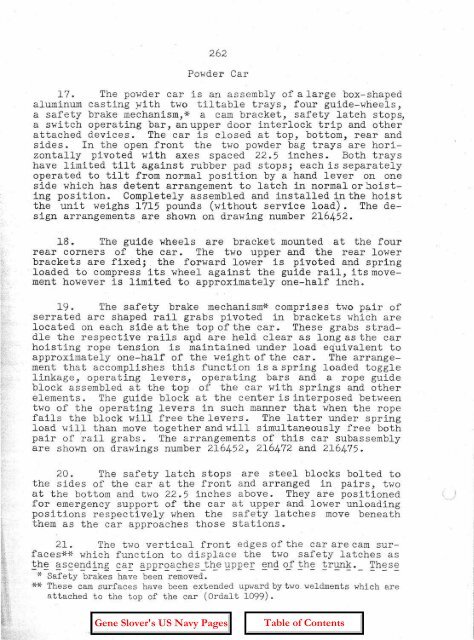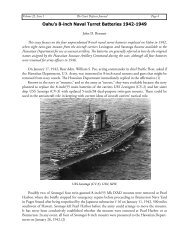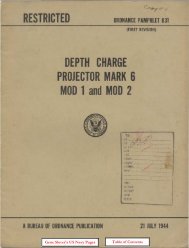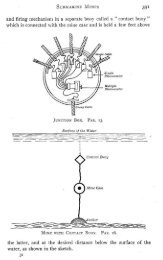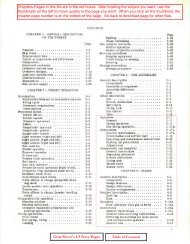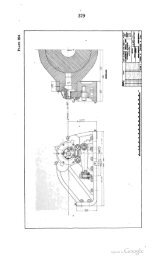OP-755 Part 2 Pages 197-401 - Personal Page of GENE SLOVER
OP-755 Part 2 Pages 197-401 - Personal Page of GENE SLOVER
OP-755 Part 2 Pages 197-401 - Personal Page of GENE SLOVER
Create successful ePaper yourself
Turn your PDF publications into a flip-book with our unique Google optimized e-Paper software.
262<br />
Powder Car<br />
17. The powder car is an assembly <strong>of</strong> a large box-shaped<br />
aluminum casting Yfith two til table trays, four guide-wheels,<br />
a safety brake mechanism, * a cam bracket, safety latch stops,<br />
a switch operating bar, anupper door interlock trip and other<br />
attached devices. The car is closed at top, bottom, rear and<br />
sides. In the open front the two powder bag trays are horizontally<br />
pivoted with axes spaced 22.5 inches. Both trays<br />
have limited tilt against rubber pad stops; each is separately<br />
opera ted to tilt from normal position by a hand lever on one<br />
side which has detent arrangement to latch in normalor~oisting<br />
position. Completely assembled and installed in the hoist<br />
the unit weighs 1715 pounds (without service load). The design<br />
arrangements.are shown on drawing number 216452.<br />
18. The guide wheels are bracket mounted at the four<br />
rear corners <strong>of</strong> the car. The two upper and the rear lower<br />
brackets are fixed;. the forward lower is pivoted and spring<br />
loaded to compress its wheel against the guide rail, its movement<br />
however is limited to approximately one-half inch.<br />
19. The safety brake mechanism* comprises two pair <strong>of</strong><br />
serra ted arc shaped rail grabs pivoted in brackets which are<br />
located on each side at the top <strong>of</strong> the car. These grabs straddle<br />
the respective rails and are held clear as long as the car<br />
hoisting rope tension is maintained under load equivalent to<br />
approximately one-half <strong>of</strong> the weight <strong>of</strong> the car. The arrangement<br />
that accomplishes this function is a spring loaded toggle<br />
~ linkage, operating levers, operating bars and a rope guide<br />
t block assembled at the top <strong>of</strong> the car with springs and other<br />
elements. The guide block at the center is interposed between<br />
two <strong>of</strong> the operating levers in such manner that when the rope<br />
fails the block will free the levers. The latter under spring<br />
load will than move together and will I<br />
pair <strong>of</strong> rail grabs. The arrangements<br />
simultaneously free both<br />
<strong>of</strong> this car subassembly<br />
are shown on drawings number 216452, 216472 and 216475.<br />
20. The safety latch stops are steel blocks bolted to<br />
the sides <strong>of</strong> the car at the front and arranged in pairs, two<br />
at the bottom and two 22.5 inches above. They are positioned<br />
for emergency support <strong>of</strong> the car at upper and lower unloading<br />
positions respectively when the safety latches move beneath<br />
them as the car approaches those stations.<br />
21. The two vertical front edges <strong>of</strong> the car are cam surfaces**<br />
which function to displace the two safety latches as<br />
!h~ ~s~e~d~n~ ~a!: ~PErs:as:h~s_th_e~PEe!: ~n~ oj' !h~ !r~._ ~h~s~<br />
* Safety brakes have been removed.<br />
** These cam surfaces have been extended upward by two.we1dments which are<br />
attached to the top <strong>of</strong> the car (Orda1t 1099).


